Srila Prabhupada and the Origins of the Hare Krishna Movement
During the 1960s and 70s, in the midst of the counter culture movement,
the Hare Krishna Movement emerged as a highly visible phenomenon. They
were known largely for distributing their sacred literature (such as the
Bhagavad Gita As It Is and Srimad Bhagvatam), usually at airports and for
distributing vegetarian meals. The devotees, chanting the names of
Krishna (Hare Krishna Hare Krishna Krishna Krishna Hare Hare/ Hare Rama
Hare Rama Rama Rama Hare Hare) with drums and cymbals in hand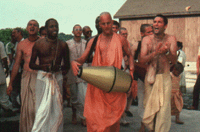 , became
a common sight on the streets of major cities around the world.
, became
a common sight on the streets of major cities around the world.
The Hare Krishna Movement, in the linage of the Brahma-Madhva-Guadiya
Vaisnava Sampradaya, was brought to America by A.C. Bhaktivedanta Swami
Srila Prabhupada 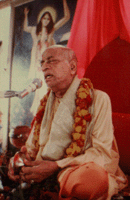 (1896-1977), who arrived on these shores from India
by freighter in September of 1965. Prabhupada was at the advanced age of 70 and had only a few dollars in his pocket when he arrived at the docks in New York City.
(1896-1977), who arrived on these shores from India
by freighter in September of 1965. Prabhupada was at the advanced age of 70 and had only a few dollars in his pocket when he arrived at the docks in New York City.
After several months Prabhupada came to the Lower East Side in New York
City. The young people there, the hippies and artists, were in the midst
of a period of experimentation with drugs and sex. Here Prabhupada
found receptive ears amongst those who were disillusioned with the
pursuit of materialism fostered by their parents, their religious
traditions, and the establishment. As poet Allen Ginsberg put it
"Prabhupada is a downtown swami who mercifully attends to burnt out
hippies on the lower east side."
For those who would become his followers, and for many well wishers and
scholars, Srila Prabhupada  embodied the ancient Vedic/Vaisnava
teachings, and was the modern day representative of an age old lineage of
Vaisnava gurus, directly in the line of Chaitanya Mahaprabhu
embodied the ancient Vedic/Vaisnava
teachings, and was the modern day representative of an age old lineage of
Vaisnava gurus, directly in the line of Chaitanya Mahaprabhu 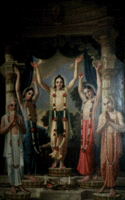 who
spread Krishna bhakti 500 years ago in India. Prabhupada's own guru
(spiritual teacher) was Srila Bhaktisiddhanta Sarasvati Thakur. Just
weeks before he passed away in 1936, Srila Bhaktisiddhanta had requested
Prabhupada to make the teaching of Bhagavad Gita available to the English
speaking world. It was almost 30 years later that Prabhupada set forth
to America to fulfill his guru's order.
who
spread Krishna bhakti 500 years ago in India. Prabhupada's own guru
(spiritual teacher) was Srila Bhaktisiddhanta Sarasvati Thakur. Just
weeks before he passed away in 1936, Srila Bhaktisiddhanta had requested
Prabhupada to make the teaching of Bhagavad Gita available to the English
speaking world. It was almost 30 years later that Prabhupada set forth
to America to fulfill his guru's order.
Within a year of his arrival in New York City, Prabhupada had rented a
small storefront and an apartment at 26 Second Avenue in New York's Lower
East Side where he incorporated his fledgling movement as the
International Society For Krishna Consciousness (ISKCON). This timeless
message of ancient India struck a cord with many young people. The
movement was soon up and running , and included the Back To Godhead
magazine and a rural ashrama in the hills of West Virginia.
In those early days, Prabhupada, accompanied by his youthful disciples
(mostly hippies), would chant for the public in nearby Tompkins Square
Park 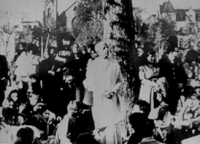 . During the next eleven years, Srila Prabhupada saw his
humble efforts on the lower east side manifest into the Hare Krishna
Movement, which became a world wide religious phenomenon, along with the
establishment of the Bhaktivedanta Book Trust, the largest publisher of
Vedic literature in the world.
. During the next eleven years, Srila Prabhupada saw his
humble efforts on the lower east side manifest into the Hare Krishna
Movement, which became a world wide religious phenomenon, along with the
establishment of the Bhaktivedanta Book Trust, the largest publisher of
Vedic literature in the world.
In the last ten years of his life Prabhupada circled the globe 14 times.
Sleeping only three hours a day, he maintained a rigorous schedule for
himself whereby he translated and wrote over 50 volumes of literature,
while nourishing and seeing to the growth of his worldwide movement 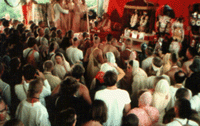 .
By the time he passed away in 1977 at the age of 82, the Hare Krishna
movement included almost 10,000 disciples and a 100 centers world wide,
including farm communities, schools and vegetarian restaurants.
.
By the time he passed away in 1977 at the age of 82, the Hare Krishna
movement included almost 10,000 disciples and a 100 centers world wide,
including farm communities, schools and vegetarian restaurants.
Chanting Audio Files: High Quality Low Quality
Need an audio player? Try WinAmp
Additional Images
1



